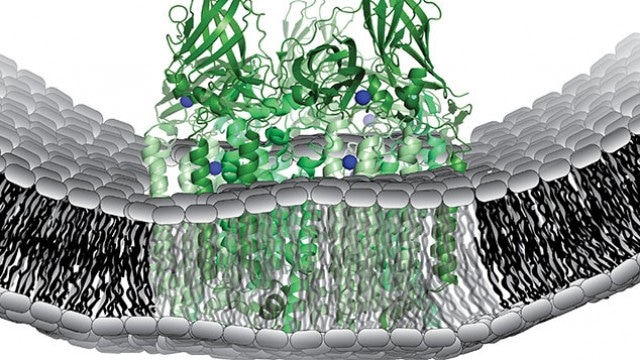May 10 2019
Methanotrophic bacteria have attracted great attention among scientists for their potential to remove methane from the environment and transform it into usable fuel. However, how, precisely, these bacteria carry out such a complex reaction in a natural way remains a mystery.
 Schematic of the metabolic enzyme, particulate methane monooxygenase, which catalyzes the methane-to-methanol reaction. (Image credit: Northwestern University)
Schematic of the metabolic enzyme, particulate methane monooxygenase, which catalyzes the methane-to-methanol reaction. (Image credit: Northwestern University)
Currently, an interdisciplinary team of researchers at Northwestern University has discovered that the enzyme causing the conversion of methane to methanol catalyzes this reaction at a location where just one copper ion is present.
This discovery can possibly lead to the preparation of new synthetic catalysts that can convert methane—a strong greenhouse gas—to readily usable methanol using the same simple mechanism.
The identity and structure of the metal ions responsible for catalysis have remained elusive for decades. Our study provides a major leap forward in understanding how bacteria perform methane-to-methanol conversion.
Amy C. Rosenzweig, Study Co-Senior Author, Northwestern University
By identifying the type of copper center involved, we have laid the foundation for determining how nature carries out one of its most challenging reactions.
Brian M. Hoffman, Study Co-senior Author, Northwestern University
The study has been published in Science. Rosenzweig is the Weinberg Family Distinguished Professor of Life Sciences, and Hoffman is the Charles E. and Emma H. Morrison Professor of Chemistry at Weinberg College of Arts and Sciences, Northwestern University.
The oxidation of methane to methanol can lead methanotrophic bacteria (or “methanotrophs”) to pack a one-two punch. That is, they can remove harmful greenhouse gas from the environment and can produce a readily usable and sustainable fuel for electricity, vehicles, and so on.
Present industrial processes for the catalysis of the conversion reaction of methane to methanol need huge pressure and high temperatures (reaching >1300°C). But methanotrophs carry out this reaction at ambient temperature and “for free.”
According to Matthew O. Ross, a graduate student co-advised by Rosenzweig and Hoffman and the study’s first author, “While copper sites are known to catalyze methane-to-methanol conversion in human-made materials, methane-to-methanol catalysis at a monocopper site under ambient conditions is unprecedented. If we can develop a complete understanding of how they perform this conversion at such mild conditions, we can optimize our own catalysts.”
The study titled “Particulate methane monooxygenase contains only mononuclear copper centers” received funding from the National Institutes of Health (award numbers GM118035, GM111097, and 5T32GM008382) and the National Science Foundation (award number 1534743).